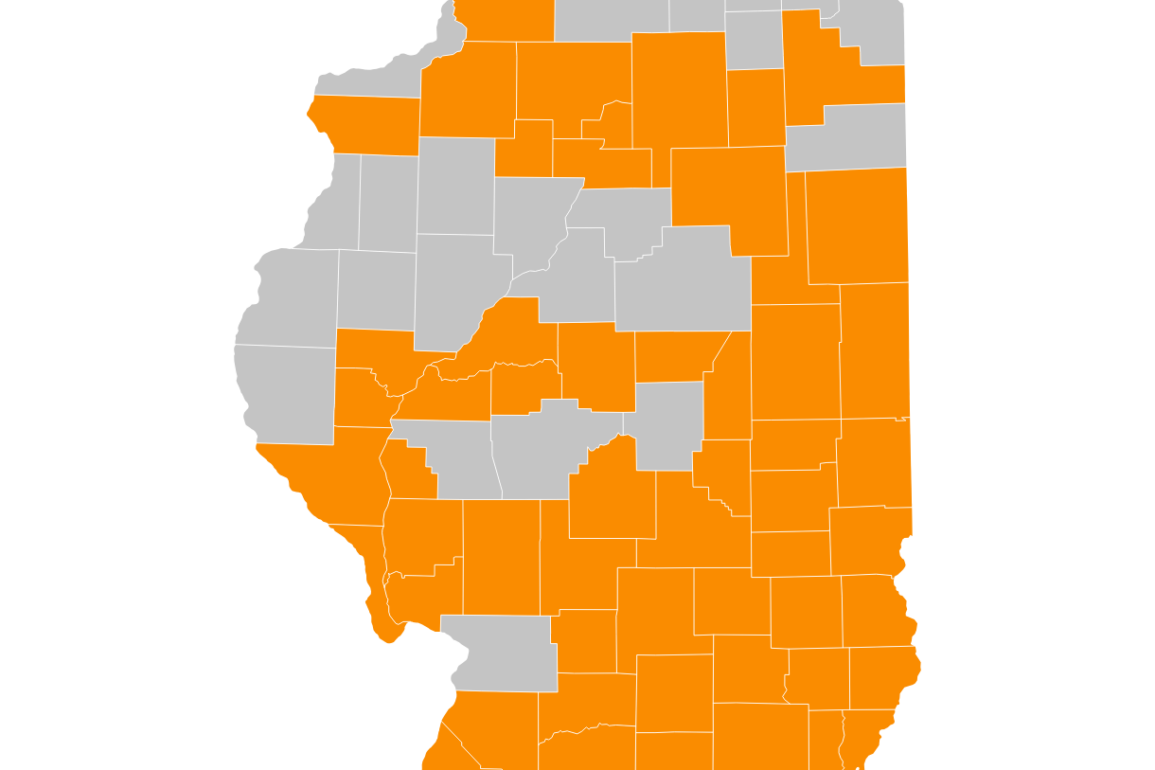The Illinois Supreme Court chamber is pictured in Springfield. (Capitol News Illinois file photo)
Courts will see longer detention hearings, new parameters for jailing accused defenders
By JERRY NOWICKI
& HANNAH MEISEL
Capitol News Illinois
news@capitolnewsillinois.com
Beginning Monday, state courts in Illinois will be prohibited from jailing individuals who are accused – but not convicted – of crimes simply because they cannot afford to post bail while they await trial.
Monetary bond will be abolished in favor of a system that seeks to give judges authority to detain defendants accused of committing violent crimes based on their level of risk to the community or of willful flight from prosecution.
The new system will require more robust hearings when someone’s freedom is on the line, while aiming to avoid disruptive pretrial incarceration if the accused person’s offense was nonviolent and they are not deemed a public safety or flight risk.
After a highly contentious election cycle last year in which Republicans used the so-called Pretrial Fairness Act to attack Democrats for being “soft on crime,” a series of legal challenges from state’s attorneys and sheriffs delayed the law’s implementation while the Illinois Supreme Court weighed its constitutionality. In a partisan 5-2 decision in July, the court’s majority agreed that lawmaker-driven bail reform was constitutional, setting up a Sept. 18 statewide rollout for the law, more than nine months after the intended Jan. 1 start date.
READ: Cash bail will end in Illinois as justices rule SAFE-T Act provisions constitutional
State Sen. Robert Peters, D-Chicago, whose negotiations on the law made him a national figure – and a lightning rod for criticism – said at the time he knows the public debate over bail reform isn’t over, even if the legal battle is.
“Let me be clear: Cash bail delegitimizes criminal justice systems and transforms them into systems that violate public safety instead of upholding it,” Peters said in a news release. “Illinois will not go back. We will only move forward with our goal of ensuring public safety for all Illinoisans, regardless of their background or financial position.”
‘Detainable’ not equal to ‘handcuff-able’
The reform was driven by the Illinois Legislative Black Caucus in January 2021 in the wake of George Floyd’s murder in Minneapolis as an effort to address systemic racism in the criminal justice system. It was part of the broader SAFE-T Act criminal justice reform – short for Safety, Accountability, Fairness and Equity-Today.
An analysis of U.S. Department of Justice data by researchers at the Loyola University of Chicago Center for Criminal Justice showed that in 2019, half of jail detainees in Illinois were Black compared to 15 percent of the state population; 33 percent were white compared to 76 percent of the population; and 14 percent were Hispanic compared to 18 percent of the population.
Of those jailed, 89 percent were being held pretrial.
READ: Contextualizing cash bail’s end
The PFA’s multi-pronged approach to limiting pretrial detention starts with law enforcement decisions in the field.
Under the law, officers retain the discretion to arrest any individual they believe to be a threat to the public safety or if they believe an arrest is the only way to keep the individual from continued violation of the law, like when a person is trespassing.
One major change, however, is that it directs – but does not require – officers to cite and release the individual if they are accused of a crime below a Class A misdemeanor, with a court date to be scheduled within 21 days.
Further changes occur at the judicial level after an arrest is made.
The PFA directly states the crimes and circumstances under which a judge can order an individual jailed as they await trial.
After weathering months of criticism and election season misinformation campaigns over the SAFE-T Act, Democratic lawmakers in December added to the list of offenses considered “detainable,” including any felony that involved the “threat of or infliction of great bodily harm or permanent disability or disfigurement.”
Another subset of crimes become detainable if a judge believes the defendant to be a flight risk.
Loyola’s CCJ analyzed arrest data from 2020 and 2021, concluding that a judge would not have been able to detain the defendant in 56 percent of arrests that occurred over that span had the PFA been in place.
But another analysis by the CCJ showed only 19 percent of individuals with pending felony cases were in jail while awaiting trial on average from 2017 through 2019, with another 17 percent on electronic monitoring or pretrial supervision.
That means about 64 percent of individuals awaiting trial for felony charges over that timespan were living in the community without any sort of supervision, the study found.
The research didn’t predict whether more or fewer defendants will be jailed while awaiting trial once the PFA takes effect. It did, however, predict that those facing lower-level charges will likely spend less time in jail, while stays may be lengthened for those accused of violent crime because they can no longer free themselves on bail if a judge orders them detained.
Lake County State’s Attorney Eric Rinehart, who supported the PFA, said the distinction between the law’s changes to judicial and law enforcement authority led to much of the misinformation that surrounded it in a contentious 2022 election season.
“The word ‘detainable’ became intermixed with the word ‘handcuff-able’… and I think police officers thought that they were going to be checking their cheat sheet under the SAFE-T Act as to whether or not they could handcuff a retail theft (suspect),” he said. “Police officers were directed not to cuff cooperative individuals who were not a threat to anyone, who were accused of committing a very small class of crimes, what we call (class) B and C misdemeanors.”
Those misdemeanors include such crimes as low-level property offenses that do not include violence.
READ: What happens when cash bail ends
Rinehart spoke at a media briefing this week organized by domestic violence survivor advocacy groups. Those groups, which worked with lawmakers to draft the law, noted it gives judges greater authority than previous law to detain individuals accused of domestic violence.
Madeleine Behr, policy director at the Chicago Alliance Against Sexual Exploitation, said state’s attorneys will – for the first time – be required to notify victims when a defendant has an initial detention hearing. The state will also be required to notify victims about the ability to obtain protective orders at the time of the initial and subsequent hearings.
Loyola researchers estimated 33 percent of those arrested in 2020 and 2021 would have been detainable based on their risk to the public, while 11 percent would have been detainable under the willful flight standard.
Domestic violence charges or violations of an order of protection made up about half the cases in which a person would have been detainable, per the research, as a detention hearing is required under the law when a defendant has violated an order of protection.
“And this really came from our community,” Behr said in the media briefing. “This came from our input – it’s recognizing the lethality and the harm at play when these kinds of violations happen.”
‘Least restrictive’ method necessary
One directive of the Pretrial Fairness Act was to ensure an individual’s appearance in court through the “least restrictive” means, meaning pretrial incarceration should be used only when necessary to ensure public safety.
For many counties, that could mean greater reliance on electronic monitoring, a type of GPS tracking that requires the defendant to wear an ankle bracelet and be tracked remotely by justice system professionals.
The PFA gives individuals on electronic monitoring two days each week to move freely to accomplish daily tasks – a departure from previous law. That provision has been ridiculed by conservatives and law enforcement groups who say that it grants too much freedom.
In 71 of Illinois’ 102 counties, electronic monitoring will be overseen by the Supreme Court’s Office of Statewide Pretrial Services, a newly formed state agency designed to assist counties with the PFA’s implementation and to fulfill a 1987 law that required all circuit courts to offer pretrial services.
It received a $23 million state appropriation for the current fiscal year after a $26 million allotment last year, which included allocations for start-up costs.
For OSPS-affiliated counties, defendants ordered to wear ankle monitors will have their movements tracked from a centralized location in Springfield with round-the-clock staffing. Electronic monitoring officers ensure defendants aren’t approaching geographically marked “exclusion zones” where the individual is prohibited from approaching. Those could include a perimeter around a person’s home if they are on house arrest or around a victim’s home if the defendant is the subject of an order of protection.
“If we have an exclusion zone case, or we have a situation where we think a defendant is attempting to remove their device, we can contact law enforcement and seek their assistance to help us remedy or respond to a violation,” retired judge Cara Smith, director of the OSPS, said in an interview.
Electronic monitoring can only be ordered by a judge, and the mission of the OSPS is to carry out those monitoring requirements once they are ordered. It’s one of several services the office offers to its member courts.
The Illinois Network for Pretrial Justice advocacy organization, however, is wary of expanding the use of electronic monitoring in the wake of cash bond’s end.
“Requiring anyone to wear an ankle shackle and be monitored in lieu of having to pay bond is an injustice that is in direct conflict with the spirit of the law and its intended impact,” the organization said in a statement.
The OSPS also pays for electronic monitoring services in its counties, costs that were previously borne by the defendant in many counties.
A new process takes shape
Under previous law, bail hearings typically occurred within 72 hours of arrest, lasting fewer than five minutes. Prosecutors would detail the defendant’s charges and potentially recommend a bail amount. The judge would then decide the conditions of their release, including how much money, if any, the defendant must post before their release.
The overhaul of the system was driven by the concern that decisions about a person’s freedom weren’t receiving enough scrutiny in court.
Beginning Monday, it will still be up to state’s attorneys to petition the court to detain an individual prior to their trial. But upon that petition, a new, more robust pretrial process will begin. Under it, the defendant is given the right to legal representation at their first hearing, with the detention hearing typically taking place within 24 or 48 hours of the first appearance in court.
The new process allows a defendant to have a public defender or private attorney at their first appearance, while also placing a greater emphasis on counties to provide pretrial services aimed at assuring a defendant’s appearance in court while also connecting them with supports focused on limiting recidivism.
For Nathan Rowland, a part-time contract public defender for Gallatin and Hamilton counties in the far southeastern corner of Illinois, that means he’ll be busier than ever before in his two-decade career as a public defender. Rowland, who works out of his private office in McLeansboro, said he still has many unanswered questions as to how the system will work.
But he also said he believes the justice system has for years been “lazily” substituting high-dollar bonds for “a particularized dangerousness finding,” which will be a requirement for keeping a defendant in jail under the PFA. And for many of his low-income clients – especially those accused of non-violent crimes – abolishing cash bail will mean they won’t languish in jail simply because they can’t afford to post bond.
“You get removed from your life and when you come back to it two weeks later or three months later, it’s in complete shambles,” Rowland said of individuals who are detained pretrial.
On Aug. 30, the Supreme Court issued an order allowing counties to hold detention hearings remotely through March 18, 2024, due to the anticipated volume of new cases and limited resources in certain areas of the state.
A new state agency takes shape
Of Illinois’ 102 counties, 31 have administered their own pretrial services for a varying number of years. The other 71 will be served by the OSPS.
Smith said the agency she leads has grown from about 10 employees in June 2022 to more than 170, and it is up and running in 70 counties, with Will County to be added to the list in October. It’s secured office space in 47 counties in addition to its central operations center in Springfield.
Its employees work to connect individuals with such support services as drug or behavioral health treatment, anger management or any other conditions imposed by the court. It also sends text message reminders of hearings among other outreach and scheduling efforts.
But perhaps its most important task alongside electronic monitoring, Smith said, was offering a “neutral” report about a defendant’s history to judges, public defenders and state’s attorneys prior to a first appearance in court.
Those reports take about an hour to prepare and usually include an interview with the defendant, a process that starts with identifying new defendants daily and carving out time to conduct interviews. The agency has completed more than 18,000 such investigations since August 2022, Smith said.
Smith said when she was a judge in juvenile court in Cook County, “you didn’t have sort of that neutral presentation.”
The presentation, she said, includes: “’Here’s what we know about this individual,’ including a detailed criminal history, if it exists, and information about, ‘are they employed, are they in school? What’s the home situation like?’”
Rowland said those services have been invaluable, noting he’d often enter a hearing room without knowing anything about the defendant he was about to represent.
The “million-dollar question,” Smith said, is how the office can best support individuals to limit them from reoffending.
“We have a support services staff who look to identify resources that might help a person succeed,” she said. “But you know, we will have – and there always have been – pretrial failures where someone… continues to engage in criminal activity.”
The new system, Smith said, will provide a more targeted approach for detention.
“I think the idea under the PFA is that we’ll be better able to identify people whose dangerousness is such that they should be detained pretrial, and everyone else is out,” she said.
Capitol News Illinois is a nonprofit, nonpartisan news service covering state government. It is distributed to hundreds of newspapers, radio and TV stations statewide. It is funded primarily by the Illinois Press Foundation and the Robert R. McCormick Foundation, along with major contributions from the Illinois Broadcasters Foundation and Southern Illinois Editorial Association.
This post was originally published on this site be sure to check out more of their content.









